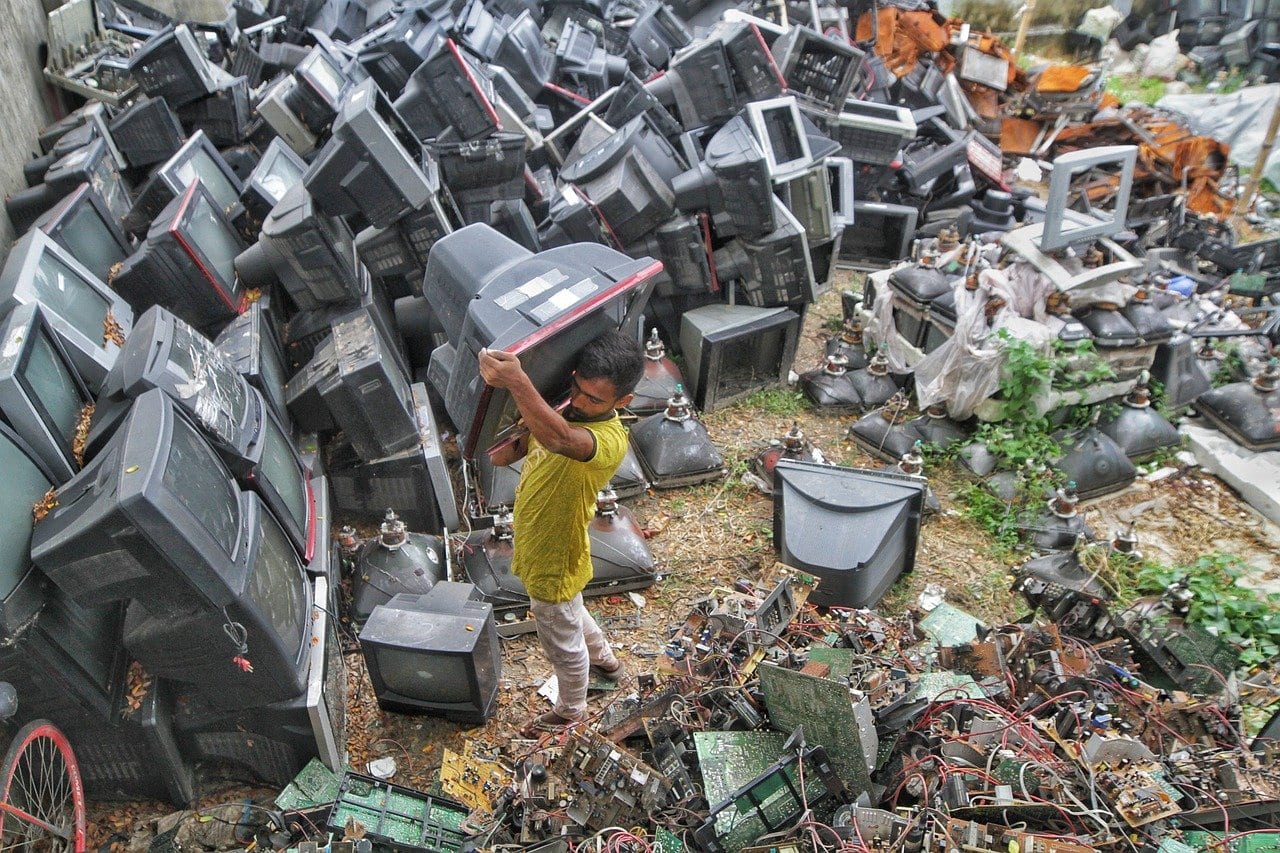According to the EPA, of the roughly 2.25 million tons of used and unwanted electronics each year, only 18% is collected for recycling and roughly 82% winds up in landfills. Clearly, as more and more e-waste is accumulating every year with our quickly developing technology, taking the steps to responsibly dispose of electronic equipment is a growing and important concern.
THE DANGERS OF IMPROPER E-WASTE DISPOSAL
Old computers, monitors, keyboards, printers, TVs, cell phones, and other electronic devices, referred to as “e-waste”, contain dangerous lead, mercury, arsenic, cadmium, and more. Many of these metals comprise circuit boards and electrical parts such as computer chips, monitors, and wiring.
Many electronics also include flame-retardant chemicals that might pose potential health risks when exposed. When these elements are safely encased in our computers and devices, e-waste dangers aren’t problematic.
However when devices break, intentionally or accidentally, they can leak and contaminate the surrounding environment. This can be in a landfill or on the streets within a region full of struggling laborers.
Over time, the toxic chemicals of a landfill’s e-waste can seep into the ground, possibly entering the water supply or escaping into the atmosphere, affecting the health of nearby communities.
People are beginning to discuss the serious aspects of this pollution in terms of “bioaccumulation” and “biomagnification”. Bioaccumulation occurs when people, plants, and animals build up levels of toxic substances in their bodies faster than they can get rid of them.
Biomagnification occurs when toxin levels accumulate within the food chain. For example, plankton might absorb low levels of mercury. Then fish that eat large amounts of plankton ingest an even larger, unhealthier dose. The problem continues as birds or humans eat mercury-tainted fish. This problem is already occurring in much of the United States’ wild-caught fish supply.
Workers in developing countries tasked with taking apart old electronics also suffer, as they generally don’t have the protective clothing and technology needed to ward off the harmful effects of toxins, and the e-waste disposal methods used are shoddy at best.

WHAT TO DO WITH YOUR E-WASTE
Your three main options are repairing, donating, or recycling old equipment. Before you pursue disposal options for a PC however, you will first want to wipe your computer’s hard drive to ensure that no one will have access to your personal data. Most of the time this will just involve simple formatting. Find detailed wipe instructions and links here.
Repair or donation
Any electronics or computer repair shop can let you know if the item is able to be repaired, or worth repairing. Repairing your electronics helps reduce the supply and demand for new products, and keeps one more item potentially out of a landfill.
If the item can’t be repaired or isn’t worth it to you, another great option is donation. As long as the product is in fairly good condition, consider giving it to a person or organization in need. Charities, schools, and senior homes are just a few places that often take donations to repair and give to someone less fortunate. Here are some links to help you find where to donate:
- Goodwill/Dell Reconnect – Since 2004, Dell and Goodwill have collaborated to collect more than 96 million pounds of electronics and have recently expanded the program to over 1,900 Goodwill locations. Simply take your unwanted devices and related equipment to a participating store or drop-off site.
- Verizon Device Recycling Program – offers consumers a way to make choices that benefit our planet, by trading in your old cell phones, tablets, and netbooks. As an added benefit, you may be eligible for a Verizon Wireless gift card when you recycle your old device.
- StRUT – Students Recycling Used Technology (StRUT) is a program that provides schools with reusable technology equipment in California, Arizona, Georgia, Oregon, Massachusetts, New Mexico, Texas, and Utah. Students develop the skills they need for a career in technology by refurbishing the donated materials. In addition, schools gain trained technicians to help with IT needs and consumer electronics waste is reduced.
- Komputers 4 R Kids – Based in southern California, Komputers 4 R Kids strives to bridge the gap in technology access between children of higher- and lower-income families. The charity will accept nearly any electronic device that is not a household appliance.
- eBay Giving Works – If you’d like to make a charitable contribution to a non-profit that doesn’t have a consumer electronics recycling program, eBay’s Giving Works program may be the perfect solution. You can auction your used goods on eBay and donate 10-100% of the final sale price to the organization of your choice.
- Make-A-Wish Foundation – The Make-A-Wish Foundation provides new computers, MP3 players, and gaming consoles to entertain children while they receive or recover from treatment. If you have any gently used electronics you would like to donate, this is a great option to make a child in need very happy.
Recycling
Recycling e-waste helps recover important natural resources, like silver and gold, for reuse and decreases the need for surface mining for new metals. Recycling is a better, environmentally friendly solution of taking metals from existing products, rather than digging up the earth and impacting nearby forestry.
“First, check to see if your device’s manufacturer will take the product back. Take-back programs are slowly expanding, and many companies allow customers to return at least some computer models and equipment when they no longer want them. Apple, Dell, Hewlett Packard, Sony, and Toshiba are a few of the companies that take back some of your old electronic devices. You may be charged a small fee to return your computer and, as the saying goes, other rules and restrictions may apply. Some companies will take back any brand of electronics; others will accept their products only. From there, your e-waste may be completely recycled by the manufacturer or refurbished for future use.”
There are myriad local and national recycling companies that will gladly take your e-waste as well, whether for free or a nominal fee. However, you should always look into the reputation of any company to ensure that they dispose of waste ethically and responsibly. Many companies have been flagged for stripping only the valuable, resell-able parts from equipment and tossing the remainders into a landfill – exactly what we’re trying to avoid!
For our readers in Texas, the Texas Recycles Program offers a directory of free and easy computer and TV recycling centers. For computers, click here. For TVs, click here.
Junk King is another nationwide service that offers e-waste disposal and recycling.
You can also do your part in the future to purchase greener, more environmentally sound products. EPEAT is an easy-to-use resource for identifying high-performance, environmentally preferable products. By using EPEAT to purchase greener electronics, you can show progress toward your sustainability goals and build your environmental reputation while reducing e-waste impact.
Techvera donates working office equipment in good condition to local charity organizations. If you’re upgrading office equipment and would like your old hardware to go to a good cause, get in touch!



